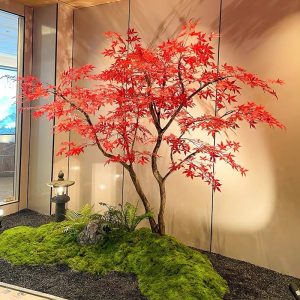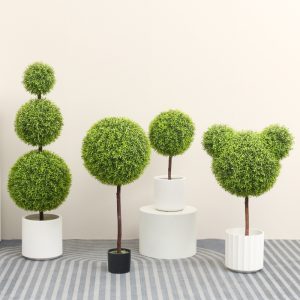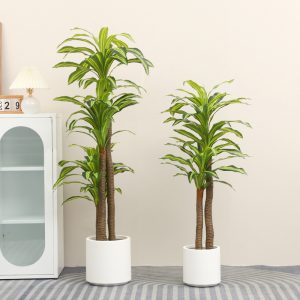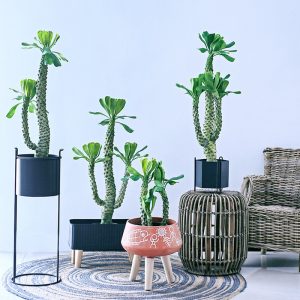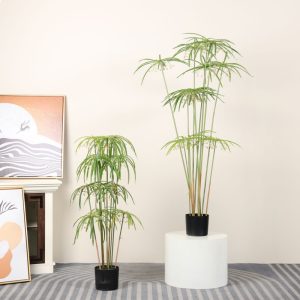At 7 a.m. in London, early summer sunlight filters through the floor-to-ceiling windows of a century-old hotel beside Hyde Park, casting diamond-shaped patches of light on the marble floor. My fellow designer Lily and I stand in the center of the lobby, watching a cleaner gently brush the leaves of the artificial fiddle leaf fig beside the reception desk. Dew-like droplets roll along the leaf veins, scattering into a fine rainbow in the morning light.
“Can you believe these are fake?” Lily can’t resist touching the edge of a leaf. The warm, smooth texture under her fingertips makes her eyes widen in surprise. “Just last week, when I brought a client here, they were still discussing this plant’s watering schedule.”
The lobby is filled with a faint cedar fragrance, mingled with the aroma of freshly baked croissants. Under an eight-meter-high dome, clusters of artificial greenery form natural space dividers — a three-story-tall artificial traveler’s palm leans against vintage leather sofas, its leaves swaying gently when the light gray linen curtains are lifted by the breeze. Most captivating is the vertical artificial green wall behind the front desk: ivy vines wrap around brass frames, interspersed with purple artificial hydrangeas. When sunlight passes through, the light and shadows on the wall slowly shift over time. These hotel artificial greenery landscaping installations subtly bring a sense of nature to every guest passing through.

From Sight to Touch: The Spatial Magic of Artificial Greenery Landscaping
On the way from the lobby to the restaurant, Lily points excitedly at an artificial monstera at the hallway corner: “Look at the pattern on this leaf — even the tiny speckles between the veins are exactly the same as the real one on my balcony.” Upon closer inspection, the leaf surface has a fine matte texture, with edges deliberately curled slightly. When the sun hits at an angle, the light and shadow on the leaf surface are richly layered.
The restaurant area shows even more thoughtful design. In this Nordic-style space with long wooden tables and rattan chairs, each table has a small artificial eucalyptus potted plant at its center. The silvery-green leaves give off a soft sheen under the warm lights. Restaurant manager Sarah, carrying coffee, smiles: “Since we switched to these artificial plants three months ago, our cleaning costs have dropped by 40%.” She gently brushes the artificial olive branch by the window. “The most surprising thing is guest feedback — many say these plants make the restaurant feel ‘more alive,’ and reservations have actually increased by 15%.”
In the afternoon, the executive lounge is filled with sunlight streaming through blinds, casting striped shadows on the floor. In the corner by the window sits a cluster of artificial ferns, their deep-green feathery fronds cascading over velvet sofas. The rhizomes are wrapped in natural moss, and up close, there’s a faint grassy scent — the hotel has added natural plant essential oils to the bases of the artificial plants to create an olfactory connection to nature. This multi-sensory immersion allows artificial greenery landscaping to go beyond simple decoration.
Rational Choices: Why High-End Hotels Prefer Artificial Greenery Landscaping
“When we first suggested using artificial plants, the owners strongly opposed it,” Lily recalls, running her fingers over the leaves of an artificial areca palm in the elevator lobby. “They thought ‘fake plants’ would lower the hotel’s class — until we ran three comparison tests.”
In the same areas, the team placed real plants, low-grade artificial plants, and high-end artificial plants made from advanced polymer materials. After three months, the results showed: the real plants developed yellowing leaves and wilted due to insufficient light, with weekly maintenance costs reaching £300; the low-grade artificial plants received frequent guest complaints for their cheap look; but the high-end artificial plants maintained perfect condition, and guest satisfaction scores actually increased by 22%.
Engineering manager Mark reveals another advantage of artificial greenery while taking us through the back-of-house areas. In a dim corridor from the banquet hall to the kitchen, several artificial bird of paradise plants remain bright green. “There’s no natural light here year-round — real plants used to last no more than two weeks.” He shines a flashlight at the plant bases: “These artificial plants have anti-mold treated bases, so even in humid conditions they won’t breed bacteria.” Since adopting hotel artificial greenery landscaping, the engineering department’s plant maintenance hours have dropped by 60%, saving nearly £20,000 annually.
Design director Emma emphasizes cultural adaptation when discussing plans: “European and American guests have very specific expectations of nature.” Pointing at an artificial olive tree in a suite, she says, “The angle of the leaves and density of the fruit follow authentic Tuscan olive trees, and even the bark cracks are aged to match.” This respect for regional culture turns artificial greenery into a carrier of brand identity — when business travelers see familiar plant forms abroad, they subconsciously feel a “sense of home.”
Light and Shadow: The 24-Hour Aesthetics of Hotel Artificial Greenery Landscaping
At night, the hotel lobby has a special charm. Warm yellow spotlights from the dome give the leaves of the artificial traveler’s palm a golden edge. Beside the concierge desk, the artificial anthurium glows with a waxy sheen, its red spathes like frozen flames. Night manager James says, “Guests love taking photos here at night — especially near the water feature with artificial bird of paradise plants, which has become a social media hotspot.”
In the early morning gym, an artificial snake plant still stands tall in the corner. “When we used real plants here, the air conditioning wind would make the leaves droop, and we worried about water dripping onto equipment,” says fitness coach Lisa while wiping down machines.
After the rain, the hotel terrace is the perfect place to test artificial plant realism. Looking at the row of artificial bamboo, rainwater slides down the joints, the leaves swaying gently in the breeze, each droplet at the tip crystal clear.
Beyond Decoration: The Emotional Value of Artificial Greenery Landscaping
Business traveler Mr. Thompson, checking out, asks the front desk about the lobby’s plant species: “My mother loves fiddle leaf figs, but we can’t keep one alive at home due to low light.” When told it’s an artificial plant, he’s astonished — and says he wants to get a few for home. “During my stay, seeing this greenery every day just made me feel better.”
Wedding planner Sophia, inspecting the banquet hall with a couple, keeps touching the artificial vines: “The bride wants a forest-themed wedding, but real plants shed leaves and pollen could cause allergies for guests.”
On the morning of departure, I pass through the lobby again and see a newly arrived family taking photos in front of the artificial green wall. The little girl tiptoes to touch the leaves, and her mother smiles: “Careful, don’t knock a leaf off.”
From London’s morning mist to New York’s night lights, artificial greenery landscaping is redefining the natural aesthetics of hotel spaces. It’s not a compromise with nature, but a way to keep the breath of a tropical rainforest inside a dry air-conditioned room, to let Mediterranean sunlight plants bloom in a Nordic winter, and to ensure that every guest who steps into the hotel can find a moment of peace in the shifting light and green.








